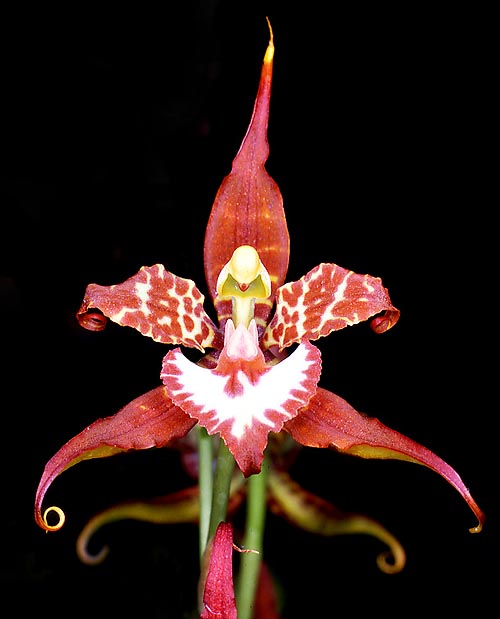Family : Orchidaceae

Text © Pietro Puccio

English translation by Mario Beltramini

The huge inflorescences of Rhynchostele cordata last 3-4 weeks © Giuseppe Mazza
The name of the genus is the combination of the Greek terms “rhynchos” = beak and “stele” = stele, pillar, with probable reference to the rostellum, beak-like extension over the anther; the name of the species is the Latin adjective “cordatus, a, um” = heart shaped, with reference to the shape of the labellum.
The Rhynchostele cordata (Lindl.) Soto Arenas & Salazar (1993) is an epiphytic species with short rhizome from which originate oblong pseudobulbs, laterally compressed, 4-7 cm long and 2-3,5 cm thick, carrying at the apex an elliptic-lanceolate leaf, rarely two, pointed, 10-30 cm long and 3-4 cm broad.
Racemose inflorescences initially erect then curved, from the base of the pseudobulbs 30-50 cm long, carrying 4-15 flowers up to about 7 cm of diameter, with sepals and petals of greenish yellow colour with brown spots and white labellum containing brown spots at the margins.
Linear-lanceolate sepals, pointed, 4-5 cm long and 0,6-1,2 cm broad, ovate-lanceolate petals, pointed, 2,5-4 cm long and 0,7-1,2 cm broad, with wavy edges, labellum from triangular to heart-shaped, pointed, 2-3 cm long.
It reproduces by seed, in vitro, and by division with each section provided with at least of 3-4 pseudobulbs.
It is a species with particularly charming flowers and long-lasting, 3-4 weeks, but usually considered of a not really easy cultivation, it requires, during the vegetative period, in summer, medium temperatures, preferably not more than 28 °C, high luminosity, but not direct sun, and humidity at around the 80%; the waterings must be regular and abundant, but allowing the compost to slightly dry up before administering water again.
In winter, it requires a period of cool and dry rest, up to the vegetative regrowth, with reduced waterings, but without having the pseudobulbs wrinkled, and temperatures between 8 and 20 °C, with high daily thermal excursion, 8-12 °C, and humidity around the 50-60%; good ventilation is essential during all seasons.
For the waterings and nebulisations is to be utilized rain water, or water obtained by reverse osmosis or demineralised; the fertilizations, duly distribute and alternated, in way to avoid salts accumulation at the roots, are to be done during the vegetative period preferably with hydro-soluble balanced products, with microelements, at ¼ of the dosage suggested on the package. It can be mounted on bark, raft of cork or of arborescent ferns roots or cultivated in pot with much draining and aerated compost, the roots must be in condition to dry up quickly; the compost can be formed by medium sliced bark fragments, charcoal and sphagnum.
The species is inscribed into the appendix II of the CITES (species whose trade is internationally ruled).
Synonyms: Odontoglossum cordatum Lindl. (1838); Odontoglossum maculatum Hook. (1855); Odontoglossum hookeri Lem. (1856); Odontoglossum lueddemannii Regel (1859); Cymbiglossum cordatum (Lindl.) Halb. (1983); Lemboglossum cordatum (Lindl.) Halb. (1984).
→ For general notions about ORCHIDACEAE please click here.
